List of ships of the Royal Yugoslav Navy
The Navy of the Kingdom of Serbs, Croats and Slovenes – from 1929, the Royal Yugoslav Navy (Serbo-Croatian: Kraljevska Jugoslavenska Ratna Mornarica, Краљевска Југословенска Ратна Морнарица; KJRM) – included a wide range of vessels during its existence from 1920 to 1945. This list includes all sea-going warships ranging from a light cruiser down to motor torpedo boats (MTBs), and also includes river monitors that operated on the Danube and other rivers. Large auxiliary vessels such as submarine tenders and tankers are included, but hulks, tugs and smaller auxiliary craft are not.
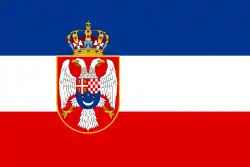
The KJRM was formed in 1920, but it was not until March 1921 that a number of former Austro-Hungarian vessels were transferred, some of which were already obsolete.[1] The only modern seagoing warships transferred were twelve torpedo boats. Little was done to improve the fleet during the 1920s, but fleet modernisation was underway from the early 1930s, with a British-made flotilla leader followed by a class of modern French-designed destroyers and German-built MTBs. Almost all of the fleet was captured by the Axis powers during the April 1941 invasion of Yugoslavia, but a few vessels escaped to form the KJRM-in-exile, which operated under British supervision. Later in the war, several vessels that had been in Italian service were returned to the KJRM-in-exile, and these were joined by a British corvette. At the end of the war, these vessels were transferred to the fledgling Yugoslav Navy.[lower-alpha 1]
Coastal defence ship
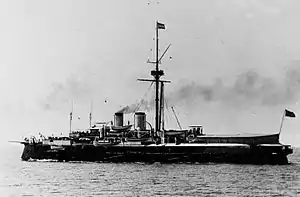
The former SMS Kronprinz Erzherzog Rudolf had been completed as an ironclad warship in 1889. She was an obsolete coastal defence ship when acquired by the Navy of the Serbs, Croats and Slovenes in 1921, and was scrapped the following year.[2][3]
| Ship/vessel | Origin | Primary armament | Displacement in long tons | Maximum speed in knots | In service | Fate |
|---|---|---|---|---|---|---|
3 × 30.5 cm (12 in) guns |
6,721 |
15.5 |
March 1921 |
Kumbor was scrapped in 1922. |
Light cruiser
%252C_jugoslawische_Schiffe.jpg.webp)
The former Gazelle-class light cruiser SMS Niobe had been commissioned into the Imperial German Navy in 1900, so by 1941, Dalmacija was obsolete and was being used as a gunnery training ship. Captured by the Italians during the April 1941 invasion of Yugoslavia, she was put into service in the Royal Italian Navy as Cattaro. She was captured from the Italians by the Germans after the Italian armistice with the Allies in September 1943, and served in the German Navy as Niobe. She also served in the Navy of the Independent State of Croatia as Zniam before being lost in December 1943.[4][5][6][7]
| Ship/vessel | Origin | Primary armament | Displacement in long tons | Maximum speed in knots | In service | Fate |
|---|---|---|---|---|---|---|
10 × 10.5 cm (4.1 in) L/40 guns |
2,916 |
21.5 |
26 June 1925 |
Zniam was run aground then destroyed by Royal Navy motor torpedo boats in December 1943. |
Destroyers
Dubrovnik
Dubrovnik was a flotilla leader built by a British shipyard in 1930–1931. Captured by the Italians in April 1941 she was put into service as Premuda, and was the most important and effective Italian war prize ship of World War II. She was captured by the Germans after the Italian armistice and served as TA32 until she was scuttled near the end of the war.[4][8][9][10]
%252C_jugoslawische_Schiffe.jpg.webp)
| Ship/vessel | Origin | Primary armament | Displacement in long tons | Maximum speed in knots | In service | Fate |
|---|---|---|---|---|---|---|
4 × Škoda 14 cm (5.5 in) guns |
1,880 |
37 |
11 October 1931 |
TA32 was scuttled at Genoa on 24 April 1945. |
Beograd class
The Beograd class were French-designed destroyers completed in 1937–1938. Zagreb was scuttled during the Axis invasion of Yugoslavia, but Beograd and Ljubljana fell into Italian hands. They served with the Italians as Sebenico and Lubiana respectively. Lubiana was lost in April 1943, but Sebenico was captured by the Germans after the Italian capitulation, and saw service as TA43 until she was scuttled at the end of the war.[11]
| Ship/vessel | Origin | Primary armament | Displacement in long tons | Maximum speed in knots | In service | Fate |
|---|---|---|---|---|---|---|
4 × Škoda 12 cm (4.7 in) guns |
1,190 |
38 |
23 December 1937 |
TA43 was scuttled at Trieste on 30 April or 1 May 1945. | ||
28 June 1938 |
Lubiana was sunk (or stranded and declared a total loss) off the Tunisian coast in April 1943. | |||||
30 March 1938 |
Zagreb was scuttled at the Bay of Kotor on 17 April 1941. |
Corvette

In early 1944, the Royal Navy Flower-class corvette HMS Mallow was transferred to the Royal Yugoslav Navy-in-exile (KJRM-in-exile) and renamed Nada. At the conclusion of the war she was transferred to the new Yugoslav Navy and renamed Partizanka.[12]
| Ship/vessel | Origin | Primary armament | Displacement in long tons | Maximum speed in knots | In service | Fate |
|---|---|---|---|---|---|---|
1 × 10.2 cm (4.0 in) gun |
925 |
16 |
early 1944 |
Partizanka was returned to the United Kingdom in 1949. |
Gunboat/Royal yacht
The gunboat and royal yacht Beli Orao came into service in 1939 and was captured by the Italians in April 1941 during the invasion. She saw service with the Italians as Alba then Zagabria before being returned to the KJRM-in-exile in late 1943. She survived the war and was transferred to the new Yugoslav Navy.[12]
| Ship/vessel | Origin | Primary armament | Displacement in long tons | Maximum speed in knots | In service | Fate |
|---|---|---|---|---|---|---|
558 |
18.5 |
June 1939 |
Unknown |
Torpedo boats
250t class

Eight former Austro-Hungarian 250t-class torpedo boats were transferred to the KJRM in 1921, and were the KJRM's only modern sea-going warships when it was formed. Two were lost or scrapped prior to World War II, and the rest were captured by the Italians during the 1941 Axis invasion and put into service by them. After the Italian capitulation, two were returned to the KJRM-in-exile. A further ship was sunk by German aircraft while still in Italian hands, and another was scuttled by her Italian crew. Of the remaining two, one was transferred to the Navy of the Independent State of Croatia and was sunk in 1944, and the other served in the German Navy as TA48 and was sunk in early 1945. The two boats that were returned to the KJRM-in-exile were transferred to the Yugoslav Navy at the end of the war and served as Golešnica and Cer.[4][13][14]
| Ship/vessel | Origin | Primary armament | Displacement in long tons | Maximum speed in knots | In service | Fate |
|---|---|---|---|---|---|---|
258–266 |
28 |
March 1921 |
Golešnica was scrapped in 1959. | |||
T2 was scrapped in 1939. | ||||||
TA48 was sunk in Trieste by Allied aircraft in February 1945. | ||||||
T4 ran aground and became a total loss in 1932. | ||||||
Cer was scrapped in 1962. | ||||||
T6 was scuttled at Rimini in September 1943. | ||||||
T7 was sunk off Murter Island in June 1944. | ||||||
T8 was sunk by German aircraft in September 1943. |
Kaiman class
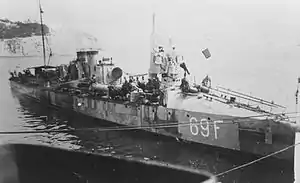
Four former Austro-Hungarian Kaiman-class torpedo boats were transferred to the KJRM in 1921, but all four were discarded and broken up between 1928 and 1930.[4][15]
| Ship/vessel | Origin | Primary armament | Displacement in long tons | Maximum speed in knots | In service | Fate |
|---|---|---|---|---|---|---|
T9 |
3 × 45 cm (17.7 in) torpedo tubes |
206–208 |
26 |
March 1921 |
All four boats were scrapped between 1928 and 1930. | |
T10 | ||||||
T11 | ||||||
T12 |
Motor torpedo boats
Uskok class
Two British-built Uskok-class torpedo boats were acquired by the KJRM in 1927. Both were captured by the Italians during the April 1941 invasion. Placed into service with new designations, they were both were lost or stricken while in Italian service.[16][17]
| Ship/vessel | Origin | Primary armament | Displacement in long tons | Maximum speed in knots | In service | Fate |
|---|---|---|---|---|---|---|
Uskok |
2 × 45.6 cm (18 in) torpedo tubes |
15 |
40 |
1927 |
The renamed MAS 1 D sank near Mljet in April 1942. | |
Četnik |
The renamed MS 47 was struck off in September 1943. |
Orjen class
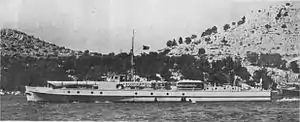
Eight German-built Orjen-class torpedo boats were purchased from Nazi Germany in the mid-to-late 1930s. Two escaped during the invasion of Yugoslavia in April 1941, and became part of the KJRM-in-exile. The remaining six were captured by the Italians and put into service by them under new designations. Two were scuttled by their crews at the time of the Italian capitulation in September 1943, and the remaining four were captured by the Germans and renamed. All four were scuttled at Salonika in October 1944. The boats that had escaped were transferred to the Yugoslav Navy at the end of the war.[18][19][20]
| Ship/vessel | Origin | Primary armament | Displacement in long tons | Maximum speed in knots | In service | Fate |
|---|---|---|---|---|---|---|
Orjen |
2 × 55 cm (22 in) torpedo tubes |
61 |
31 |
1936 |
The renamed MS 41 was scuttled at Monfalcone in September 1943. | |
Durmitor |
Unknown |
The renamed TČ 391 was struck off in 1963. | ||||
Suvobor |
1937 |
The renamed MS 45 was scuttled at Cattolica in September 1943. | ||||
Kajmakčalan |
Unknown |
The renamed TČ 392 was struck off in 1963. | ||||
Velebit |
Unknown |
All four boats were sunk at Salonika in October 1944. | ||||
Dinara |
1939 | |||||
Rudnik |
1939 | |||||
Triglav |
1939 |
Submarines
Hrabri class

Two British-made Hrabri-class submarines were brought into service in 1927. During the April 1941 invasion, one escaped to join the KJRM-in-exile, while the other was captured by the Italians then scrapped. The boat that escaped was used as an anti-submarine warfare training vessel, and was transferred to the Yugoslav Navy at the end of the war and renamed Tara.[12]
| Ship/vessel | Origin | Primary armament | Displacement in long tons | Maximum speed in knots | In service | Fate |
|---|---|---|---|---|---|---|
6 × 53.3 cm (21 in) torpedo tubes |
975 (surfaced) |
15.7 (surfaced) |
1927 |
Hrabri was scrapped by the Italians in 1941. | ||
Tara was struck off in 1954. |
Osvetnik class
Two French-made Osvetnik-class submarines were commissioned in 1928–1929. Both were captured by the Italians during the April 1941 invasion, after which they were put into service as training and experimentation boats under new names. They were both scuttled at the time of the Italian capitulation.[12]
| Ship/vessel | Origin | Primary armament | Displacement in long tons | Maximum speed in knots | In service | Fate |
|---|---|---|---|---|---|---|
6 × 55 cm (22 in) torpedo tubes |
630 (surfaced) |
14.5 (surfaced) |
1929 |
The renamed Francesco Rismondo was scuttled at Bonifacio in September 1943. | ||
1928 |
The renamed Antonio Bajamonti was scuttled at La Spezia in September 1943. |
Minelayers
Galeb class
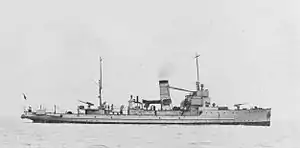
Six German-built Galeb-class minelayers were purchased soon after the KJRM was established. All six were captured by the Italians during the April 1941 invasion, and were put into service by them under new names. Five were lost prior to the Italian capitulation in September 1943, but one was transferred to the KJRM-in-exile in December of that year, and survived the war to serve in the post-war Yugoslav Navy as Pionir then Zelengora.[4]
| Ship/vessel | Origin | Primary armament | Displacement in long tons | Maximum speed in knots | In service | Fate |
|---|---|---|---|---|---|---|
Galeb |
2 × Škoda 9 cm (3.5 in) L/45 guns |
500 |
16 |
July 1921 |
The renamed Selve was broken up in 1948. | |
Orao |
The renamed Zelengora was disposed of in 1962. | |||||
Labud |
The renamed Oriole was scuttled in July 1943. | |||||
Jastreb |
The renamed Zirona was destroyed by her own crew in November 1941. | |||||
Kobac |
The renamed Unie was destroyed in January 1943. | |||||
Sokol |
The renamed Eso was sunk in January 1943. | |||||
Zmaj
The German-built seaplane tender Zmaj was commissioned into the KJRM in 1930, but was converted to a minelayer in 1937. Captured by the Germans in April 1941, she saw service in the seaplane tender, aircraft rescue and troop transport roles as Drache. In late 1942, she was re-commissioned as a minelayer, and was used for shipboard trials with helicopters in 1943 before being sunk in September 1944.[18]
| Ship/vessel | Origin | Primary armament | Displacement in long tons | Maximum speed in knots | In service | Fate |
|---|---|---|---|---|---|---|
2 × 8.35 cm (3.29 in) L/55 anti-aircraft guns |
1,840 |
15 |
1930 |
Drache was sunk in September 1944. |
Malinska class
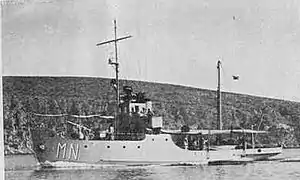
In 1931, the KJRM acquired five former Austro-Hungarian minelayers, known as the Malinska class. In April 1941, they were all captured by the Italians, although one had been scuttled, it was raised and repaired. Two were captured by the Germans at the time of the Italian capitulation in September 1943, and were lost in their hands or while serving with the Navy of the Independent State of Croatia. Three were handed back to the KJRM-in-exile and survived the war to see service in the new Yugoslav Navy.[12]
| Ship/vessel | Origin | Primary armament | Displacement in long tons | Maximum speed in knots | In service | Fate |
|---|---|---|---|---|---|---|
Malinska |
1 × 6.6 cm (2.6 in) L/30 anti-aircraft gun |
126 |
9 |
1931 |
Unknown | |
Marjan |
The renamed Ugliano was probably lost in German hands. | |||||
Meljine |
Unknown | |||||
Mljet |
Unknown | |||||
Mosor |
The renamed Pasman was scrapped in 1954. | |||||
Minesweepers
At the time of its formation in 1921, the KJRM obtained four former Austro-Hungarian Schichau-class torpedo boats that had been converted into minesweepers. Three were discarded soon after, but one served as a training vessel until the April 1941 invasion, at which time she was captured by the Italians. The Germans captured her in September 1943 and she was lost in their hands some time later.[21][22][23]
| Ship/vessel | Origin | Primary armament | Displacement in long tons | Maximum speed in knots | In service | Fate |
|---|---|---|---|---|---|---|
D1 |
2 × 3.7 cm (1.5 in) L/23 guns |
87–89 |
19 |
March 1921 |
D1 was discarded in 1924. | |
D2 |
D2 was lost in German hands. | |||||
D3 |
These two boats were also discarded in 1924. | |||||
D4 |
Submarine tenders
Two submarine tenders were operated by the KJRM, one was converted from a German-built water tanker obtained from the Austro-Hungarians, and the other was a British commercial vessel converted to the role at the time British-built submarines were acquired. The latter ship was captured by the Italians in April 1941 but survived the war to see service in the post-war Yugoslav Navy.[24][25][26]
| Ship/vessel | Origin | Displacement in long tons | In service | Fate |
|---|---|---|---|---|
Sitnica |
370 |
March 1921 |
Unknown | |
Hvar |
2,600 |
1927 |
Hvar was scrapped in 1953. |
Salvage ships
The KJRM operated two salvage ships. The first was a former Austro-Hungarian vessel which was scrapped in the late 1920s. She was replaced by a German-built ship.[27]
| Ship/vessel | Origin | Displacement in long tons | In service | Fate |
|---|---|---|---|---|
Moćni |
265 |
March 1921 |
Moćni was scrapped in 1929. | |
Spasilac |
740 |
1929 |
Unknown |
Tankers
The KJRM had two tankers, one for oil and one for water. The oil tanker was sunk in Italian hands in 1943, and the water tanker was deleted at the end of the war.[28][29]
| Ship/vessel | Origin | Displacement in long tons | In service | Fate |
|---|---|---|---|---|
Lovćen |
Unknown |
561 |
1932 |
Lovćen was deleted in 1945. |
Perun |
4,500 |
1939 |
Perun was sunk in March 1943. |
River flotilla
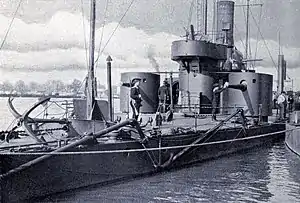
The KJRM inherited four river monitors from the Austro-Hungarian Navy, each from a different class. In April 1941, one was sunk, and the rest were scuttled. One of the scuttled ships was raised and scrapped. The other two were raised and put to use by the Navy of the Independent State of Croatia, and were lost late in the war, with one being raised after the war and put into service until 1962.[4]
| Ship/vessel | Origin | Primary armament | Displacement in long tons | Maximum speed in knots | In service | Fate |
|---|---|---|---|---|---|---|
2 × 12 cm (4.7 in) L/45 guns 2 × 12 cm L/10 howitzers |
570 |
13.5 |
March 1921 |
Vardar was scuttled in April 1941. | ||
2 × 12 cm L/35 guns 1 × 12 cm L/10 howitzer |
430 |
13 |
Sava was struck in 1962. | |||
2 × 12 cm L/45 guns 3 × 12 cm L/10 howitzers |
528 |
13 |
Drava was raised by Hungary and scrapped during the war. | |||
2 × 12 cm L/35 guns |
441 |
10 |
The renamed Bosna was mined in June 1944 |
See also
Notes
- In each section of this list, the citations within the text also relate to the table.
Footnotes
- Vego 1982, pp. 344–345.
- Vego 1982, pp. 344 & 347.
- Gardiner 1979, p. 271.
- Chesneau 1980, p. 357.
- Rohwer & Hümmelchen 1992, pp. 181 & 294.
- Hildebrand, Röhr & Steinmetz 1993, p. 158.
- Gröner 1990, pp. 100–101.
- Lenton 1975, p. 105.
- Brescia 2012, p. 134.
- Whitley 1988, p. 313.
- Chesneau 1980, pp. 357–358.
- Chesneau 1980, p. 358.
- Greger 1976, pp. 58 & 60.
- Gardiner 1983, p. 388.
- Greger 1976, p. 55.
- Chesneau 1980, pp. 358–359.
- Brescia 2012, p. 157.
- Chesneau 1980, p. 359.
- Fraccaroli 1974, pp. 176–177.
- Paterson 2015, p. 216.
- Vego 1982, pp. 344, 347 & 356.
- Gardiner 1985, p. 426.
- Niehorster 2016.
- Vego 1982, pp. 345, 349–350 & 356.
- Haworth 2016a.
- Haworth 2016b.
- Vego 1982, pp. 345, 349 & 356.
- Vego 1982, pp. 350 & 356.
- Haworth 2016c.
References
Books
- Brescia, Maurizio (2012). Mussolini's Navy. Barnsley, South Yorkshire: Seaforth Publishing. ISBN 978-1-59114-544-8.CS1 maint: ref=harv (link)
- Chesneau, Roger, ed. (1980). Conway's All the World's Fighting Ships, 1922–1946. London, England: Conway Maritime Press. ISBN 978-0-85177-146-5.CS1 maint: ref=harv (link)
- Fraccaroli, Aldo (1974). Italian Warships of World War II. London, England: Ian Allan Publishing. OCLC 834485650.CS1 maint: ref=harv (link)
- Gardiner, Robert, ed. (1979). Conway's All the World's Fighting Ships, 1860–1905. London, England: Conway Maritime Press. ISBN 978-0-85177-133-5.CS1 maint: ref=harv (link)
- Gardiner, Robert, ed. (1983). Conway's All the World's Fighting Ships, 1947–1982. Annapolis, Maryland: Naval Institute Press. ISBN 978-0-87021-919-1.CS1 maint: ref=harv (link)
- Gardiner, Robert, ed. (1985). Conway's All the World's Fighting Ships, 1906–1921. London, England: Conway Maritime Press. ISBN 978-0-85177-245-5.CS1 maint: ref=harv (link)
- Greger, René (1976). Austro-Hungarian Warships of World War I. London, England: Allan. ISBN 978-0-7110-0623-2.CS1 maint: ref=harv (link)
- Gröner, Erich (1990). German Warships: 1815–1945. Annapolis, Maryland: Naval Institute Press. ISBN 978-0-87021-790-6.CS1 maint: ref=harv (link)
- Hildebrand, Hans H.; Röhr, Albert; Steinmetz, Hans-Otto (1993). Die Deutschen Kriegsschiffe [The German Warships] (in German). 6. Ratingen, Germany: Mundus Verlag. ISBN 3-7822-0237-6.CS1 maint: ref=harv (link)
- Lenton, Henry Trevor (1975). German Warships of the Second World War. London, England: Macdonald and Jane's. ISBN 978-0-356-04661-7.CS1 maint: ref=harv (link)
- Paterson, Lawrence (2015). Schnellboote: A Complete Operational History. Barnsley, England: Seaforth Publishing. ISBN 978-1-84832-083-3.CS1 maint: ref=harv (link)
- Rohwer, Jürgen; Hümmelchen, Gerhard (1992). Chronology of the War at Sea 1939–1945: The Naval History of World War Two. Annapolis, Maryland: Naval Institute Press. ISBN 978-1-55750-105-9.CS1 maint: ref=harv (link)
- Whitley, M. J. (1988). Destroyers of World War Two: An International Encyclopedia. Annapolis, Maryland: Naval Institute Press. ISBN 978-0-87021-326-7.CS1 maint: ref=harv (link)
Journals
Websites
- Niehorster, Leo (2016). "Balkan Operations Order of Battle Royal Yugoslavian Navy Coastal Defense Command 6th April 1941". Leo Niehorster. Retrieved 1 December 2016.CS1 maint: ref=harv (link)
- Haworth, R.B. (2016a). "Najade". Miramar Ship Index. New Zealand: R.B. Haworth. 6100091. Retrieved 1 December 2016.CS1 maint: ref=harv (link)
- Haworth, R.B. (2016b). "Umtali (Hvar)". Miramar Ship Index. New Zealand: R.B. Haworth. 1105810. Retrieved 1 December 2016.CS1 maint: ref=harv (link)
- Haworth, R.B. (2016c). "Perun". Miramar Ship Index. New Zealand: R.B. Haworth. 6110884. Retrieved 1 December 2016.CS1 maint: ref=harv (link)